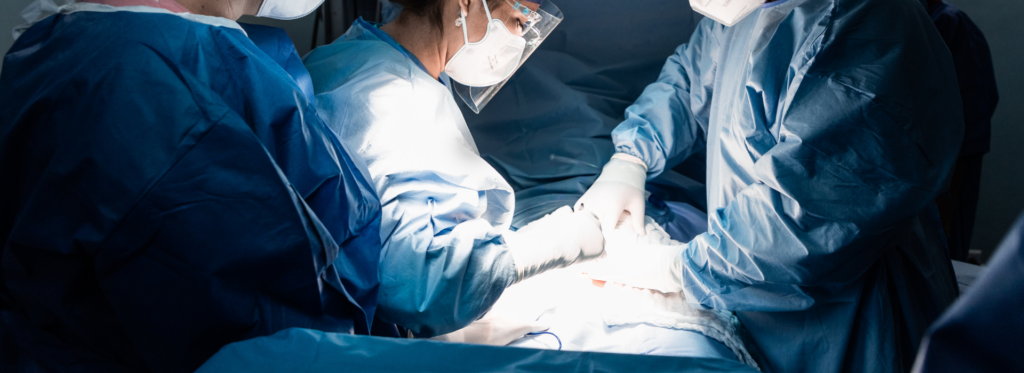Total knee replacement surgery is a highly effective procedure designed to relieve pain and restore mobility in individuals suffering from severe knee arthritis or injury. This surgical intervention involves replacing the damaged knee joint with an artificial implant, significantly improving the patient’s quality of life. In this blog, we will provide a step-by-step overview of the total knee replacement surgery procedure, covering everything from preparation to post-operative recovery.

What is Total Knee Replacement Surgery?
Total knee replacement surgery, also known as total knee arthroplasty, is a medical procedure where the worn-out or damaged surfaces of the knee joint are replaced with artificial components. This surgery is recommended for individuals suffering from osteoarthritis, rheumatoid arthritis, post-traumatic arthritis, or other degenerative joint diseases that cause chronic pain and mobility issues.
Step-by-Step Overview of the Total Knee Replacement Surgical Procedure
1. Preoperative Preparation
Before undergoing a total knee replacement surgery procedure, patients must go through a thorough evaluation. This stage involves:
- Medical Assessment: A complete health evaluation, including blood tests, imaging studies (X-rays, MRI, or CT scans), and a review of medical history.
- Patient Education: The surgeon discusses the total knee replacement surgery procedure, expected outcomes, and potential risks.
- Preoperative Exercises: Strengthening exercises are recommended to improve recovery after surgery.
- Medications & Anesthesia Planning: The medical team decides on anesthesia (general or spinal) based on the patient’s health status.
2. Administering Anesthesia
Before starting the total knee replacement surgical procedure, anesthesia is administered to ensure a pain-free experience. The types of anesthesia used include:
- General Anesthesia: The patient is put into a deep sleep throughout the procedure.
- Spinal Anesthesia: Numbs the lower half of the body while the patient remains awake but relaxed.
3. Making the Surgical Incision
The surgeon begins the total knee replacement surgical procedure by making an incision at the front of the knee. The incision is usually about 6–10 inches long, allowing the surgeon access to the knee joint.
4. Removing the Damaged Knee Components
- The surgeon carefully moves the kneecap aside to expose the damaged joint.
- The worn-out cartilage and bone surfaces from the femur (thigh bone) and tibia (shin bone) are removed using specialized surgical instruments.
- Any bone spurs or loose fragments are also cleared to ensure a smooth implant fit.
5. Implanting the Artificial Knee Components
Once the damaged tissues are removed, the surgeon implants the artificial components:
- Femoral Component: A metal cap is placed on the end of the thigh bone.
- Tibial Component: A metal and plastic implant is attached to the top of the shin bone.
- Patellar Component (if necessary): A plastic button is placed on the back of the kneecap for smooth movement.
These components replicate the natural knee joint and help restore function and stability.
6. Securing the Implant
The implants are secured using medical-grade bone cement or a press-fit technique, allowing natural bone growth to hold the implant in place.
7. Checking the Joint Alignment and Function
Before closing the incision, the surgeon tests the new knee joint for:
- Proper movement: Ensuring smooth bending and straightening of the knee.
- Stability: Checking for proper alignment to prevent post-operative complications.
- Flexibility and Fit: Ensuring that the components are placed correctly and function naturally.
8. Closing the Incision
Once the implant is securely placed, the surgeon:
- Repositions the kneecap.
- Closes the incision with sutures or staples.
- Applies a sterile bandage to protect the wound.
9. Immediate Post-Surgical Care
After completing the total knee replacement surgical procedure, the patient is moved to the recovery room, where medical staff monitor vital signs, pain levels, and overall response to surgery.
Post-Operative Recovery and Rehabilitation
1. Hospital Stay and Pain Management
- Most patients stay in the hospital for 1-3 days after surgery.
- Pain management includes medications, ice therapy, and elevation to reduce swelling.
- Early mobilization with assistance helps prevent blood clots.
2. Physical Therapy and Rehabilitation
- First Few Days: Patients start with gentle range-of-motion exercises.
- First Few Weeks: Walking with a walker or crutches to regain strength.
- 6-12 Weeks: Gradual increase in activity, including stair climbing and balance exercises.
- Long-Term Recovery: Full recovery can take 3-6 months, with continued strength training.
3. Lifestyle Changes and Long-Term Care
- Weight Management: Maintaining a healthy weight reduces stress on the knee.
- Low-Impact Activities: Swimming, cycling, and walking help maintain joint health.
- Regular Follow-Ups: Routine check-ups with the surgeon ensure long-term success of the knee implant.
Risks and Complications of Total Knee Replacement Surgery
Although the total knee replacement surgery procedure is highly successful, potential risks include:
- Infection
- Blood clots
- Implant loosening or wear
- Stiffness or limited range of motion
- Nerve or blood vessel injury
Surgeons take every precaution to minimize these risks, and adherence to post-operative care significantly reduces complications.
Conclusion
The total knee replacement surgery procedure is a well-established and highly effective treatment for severe knee arthritis and joint damage. By understanding the total knee replacement surgical procedure in detail, patients can make informed decisions and prepare for a smooth recovery. With proper preoperative preparation, surgical expertise, and post-operative rehabilitation, individuals undergoing total knee replacement surgery can regain mobility and enjoy an active lifestyle free from chronic knee pain.
If you are considering total knee replacement surgery, consult with a qualified orthopedic specialist to determine the best approach for your specific condition.
